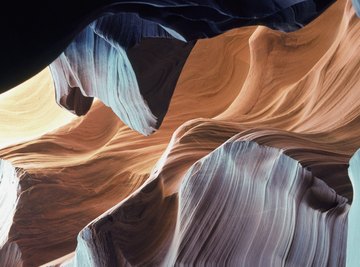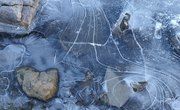
Weathering is the natural process that causes rock to break down over time. Erosion is the moving or shifting of those smaller pieces of broken rock by natural forces, such as wind, water or ice. Weathering must occur before erosion can take place. Fifth- and sixth-grade teachers often incorporate lessons on weathering and erosion into their science curriculum.
Weathering: Rock and Color Changes
Weathering doesn't involvement movement of the broken rock away from the primary source. There are two primary types of weathering -- chemical and mechanical. Chemical and mechanical weathering can also occur simultaneously. A less common type of weathering -- biological weathering -- occurs when fungi and bacteria decompose rock. Chemical weathering exists when rock interacts with chemicals -- oxygen, carbon dioxide, water or acids -- and the rock breaks down or changes color. Chemical weathering often occurs in caves, resulting in the formation of stalactites and stalagmites. Mechanical weathering occurs when rock formations break into smaller pieces as a result of heat from the sun, running water, shifting ice, or growing tree roots.
Examples of Weathering
Weathering occurs on the surface, or near the surface of rock. For example, wind and rain can cause smaller rocks to break away from larger rocks on the side of a mountain. Rock formations often crack and break apart when water fills fissures in the rock and the water freezes and expands.
Erosion: Movement and Relocation
Erosion always involves movement. Erosion occurs after weathering has already decomposed, loosened or broken apart pieces of rock, and the broken pieces start to move away from their original location. The rock fragments and soil -- sometimes as small as tiny sand particles -- are carried away by wind, water or irrigation. Weathering causes changes in the rock, such as color variations or decomposition, but erosion only moves the sediment from one place to another.
Erosion Illustrations
Several types of erosion exist. Mass wasting occurs when rock fragments move downhill due to gravity. Examples of mass wasting include mud slides, rock slides and debris flows after storms and significant weather events. Examples of erosion caused by air, water or ice include shoreline erosion caused by oceans, seas, rivers, streams and lakes, and embankment erosion caused by flooding. Eroded loose soil can lead to dust storms in dry regions. The Grand Canyon in Arizona and the Natural Bridge in Virginia are landmark examples of erosion.
References
- Virginia Department of Education: What Is the Difference Between Weathering and Erosion?
- Unites States Geological Survey: What's the Difference Between Weathering and Erosion
- Brighton Tuition: Weathering and Erosion -- How Rocks Are Broken Down
- Alabama Learning Exchange: Showing the Difference Between Erosion and Weathering
About the Author
As curriculum developer and educator, Kristine Tucker has enjoyed the plethora of English assignments she's read (and graded!) over the years. Her experiences as vice-president of an energy consulting firm have given her the opportunity to explore business writing and HR. Tucker has a BA and holds Ohio teaching credentials.
Photo Credits
Medioimages/Photodisc/Photodisc/Getty Images
